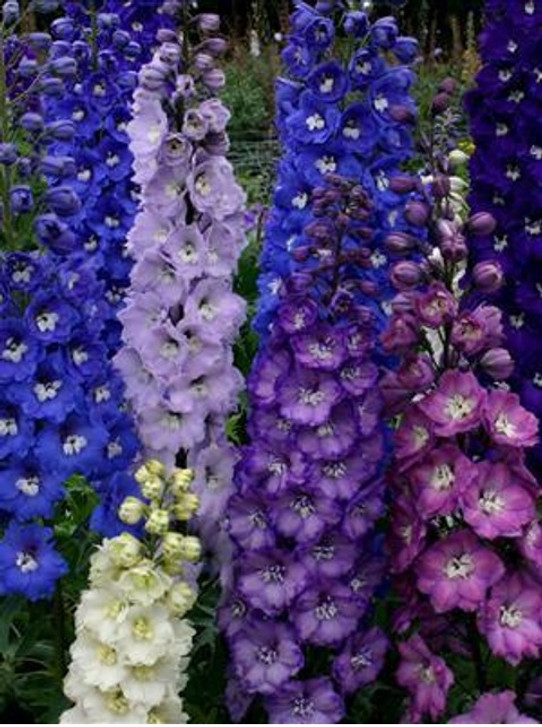Delphiniums are a genus of flowering plants in the family Ranunculaceae. They are known for their tall spikes of blue, purple, pink, white, or yellow flowers. Delphiniums are native to the Northern Hemisphere and can be found in a variety of habitats, including meadows, forests, and mountains.
There are over 300 species of delphinium, and they come in a variety of sizes, from dwarf varieties that only grow a few inches tall to giants that can reach 6 feet in height. Delphiniums are typically perennials, but some species are annual or biennials.
Delphiniums are toxic to humans and animals, so it is important to keep them away from children and pets. However, they are beautiful and popular garden plants, and they can be used to add a touch of color and height to any garden.
Common types of delphiniums:
- Delphinium elatum is a tall, stately perennial that can grow up to 6 feet tall. It has large, showy flowers in a variety of colors, including blue, purple, pink, white, and yellow.
- Delphinium belladonna is a shorter, more compact perennial that grows about 3 feet tall. It has smaller flowers than D. elatum, but they are just as beautiful.
- Delphinium grandiflorum is a hybrid delphinium that is known for its large, double flowers. It is a bit more difficult to grow than other types of delphiniums, but it is well worth the effort.
Delphiniums are relatively easy to care for, but they do require some special attention. They need full sun and well-drained soil. They should be watered regularly, but they should not be overwatered. Delphiniums are also susceptible to pests and diseases, so it is important to inspect them regularly and take preventative measures.
With proper care, delphiniums can thrive for many years and add a touch of beauty to any garden.
How to plant delphiniums:
- Choose a planting site that receives full sun for at least 6 hours per day. Delphiniums also prefer well-drained soil, so avoid planting them in areas that are prone to flooding.
- Prepare the planting site by digging a hole that is twice the width and depth of the delphinium's root ball. Add some compost or well-rotted manure to the soil to improve drainage and fertility.
- Place the delphinium in the hole and make sure that the top of the root ball is level with the soil surface. Backfill the hole with soil and water thoroughly.
- Space the delphiniums 1 to 3 feet apart, depending on the variety.
- Stake the delphiniums as soon as they start to grow tall. This will help to prevent the flower stalks from toppling over in strong winds.
- Water the delphiniums regularly, especially during hot, dry weather.
- Fertilize the delphiniums in the spring and summer with a high-nitrogen fertilizer.
- Deadhead the spent flowers to encourage more blooms.
Tips for growing delphiniums:
- Delphiniums are susceptible to slugs and snails, so it is important to protect them from these pests.
- Delphiniums can be susceptible to powdery mildew, so it is important to water them in the morning so that the leaves have a chance to dry off before nightfall.
- Delphiniums are hardy perennials, but they may need to be divided every 3 to 4 years to keep them healthy.
More facts about Delphiniums
- Delphiniums have a long and storied history, dating back to ancient Greece. The name "delphinium" comes from the Greek word "delphis," which means "dolphin." This is because the unopened buds of the delphinium flower are said to resemble the nose of a dolphin.
- Delphiniums were first cultivated in Greece and Rome, and they were used for both ornamental and medicinal purposes. The Greeks believed that delphiniums could ward off evil spirits, and they were also used to treat a variety of ailments, including fever, headache, and snakebite.
- Delphiniums were introduced to England in the 16th century, and they quickly became popular garden flowers. In the 19th century, there was a great deal of hybridization of delphiniums, and many new varieties were created. These new varieties were larger, more colorful, and more resistant to pests and diseases than the older varieties.
- Today, delphiniums are still popular garden flowers, and they are also used as cut flowers. There are over 300 species of delphinium, and they come in a wide variety of colors, including blue, pink, purple, white, and yellow.
- In Greek mythology, the delphinium flower was said to have originated from the blood of the Greek hero Ajax, who was killed during the Trojan War.
- Delphiniums were used by Native Americans to make blue dye.
- In the Middle Ages, delphiniums were used to treat a variety of ailments, including fever, headache, and snakebite.
- In the 19th century, there was a great deal of hybridization of delphiniums, and many new varieties were created.

